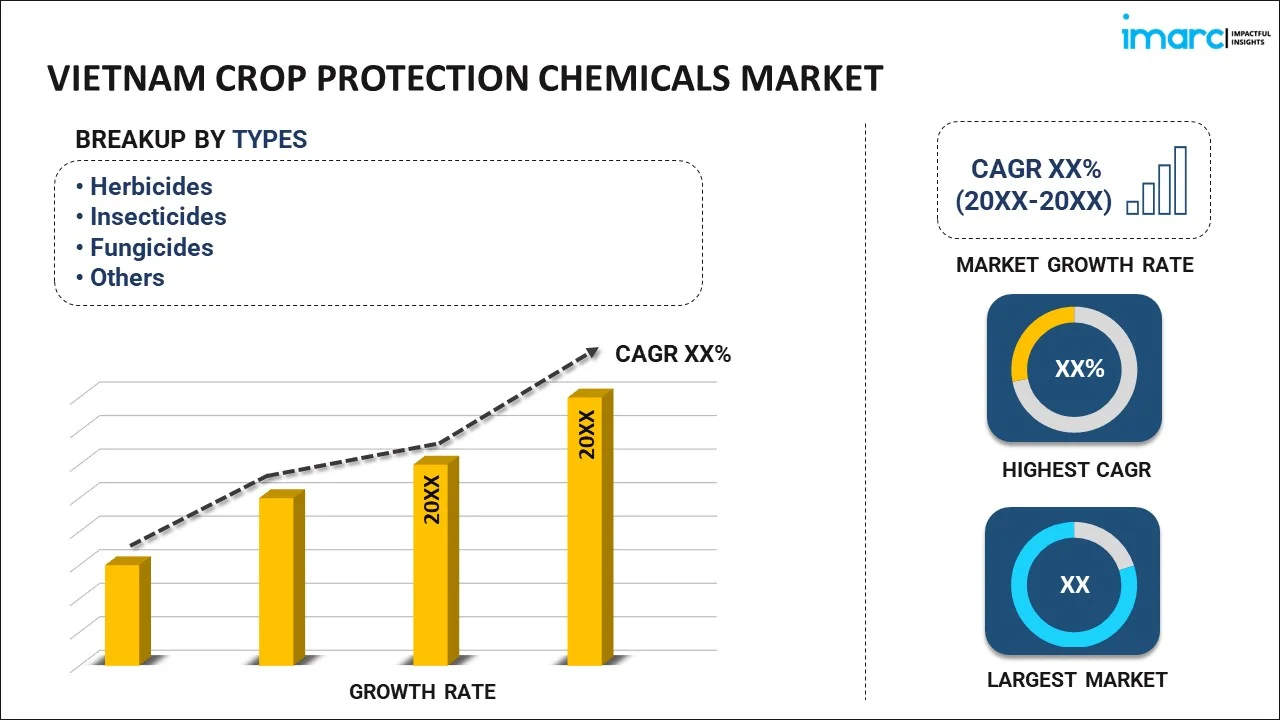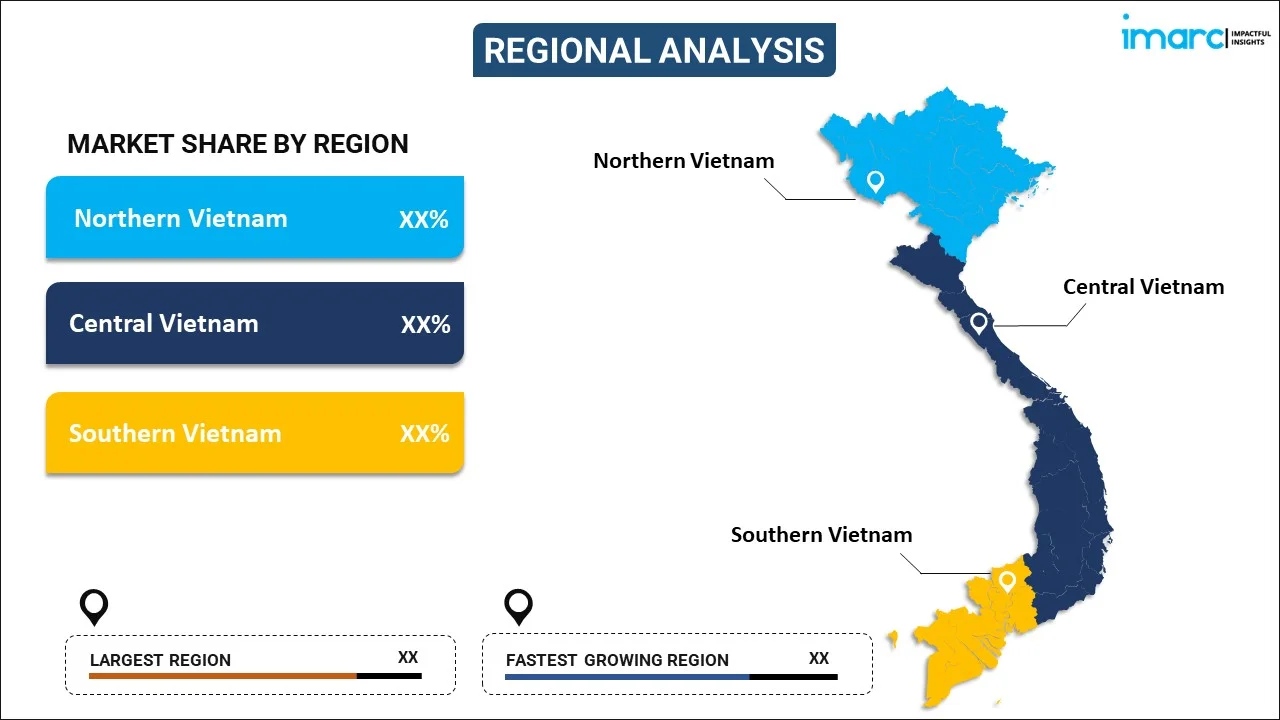
Vietnam Crop Protection Chemicals Market Report by Type (Herbicides, Insecticides, Fungicides, and Others), Origin (Synthetic, Bio-based), Application (Grains and Cereals, Pulse and Oilseeds, Fruits and Vegetables, Commercial Crops, and Others), and Region 2026-2034
Market Overview:
Vietnam crop protection chemicals market size reached USD 398.1 Million in 2025. Looking forward, IMARC Group expects the market to reach USD 540.2 Million by 2034, exhibiting a growth rate (CAGR) of 3.45% during 2026-2034. The growing necessity for sustainable agriculture, innovations in agrochemical technology, advancements in data analytics, government initiatives, demand for quality food products, and collaborations between agricultural bodies and chemical suppliers represent some of the key factors driving the industry.
|
Report Attribute
|
Key Statistics
|
|---|---|
|
Base Year
|
2025
|
|
Forecast Years
|
2026-2034
|
|
Historical Years
|
2020-2025
|
| Market Size in 2025 | USD 398.1 Million |
| Market Forecast in 2034 | USD 540.2 Million |
| Market Growth Rate 2026-2034 | 3.45% |
Access the full market insights report Request Sample
Crop protection chemicals, also known as pesticides, are used to control, repel, or kill pests that affect crop yield and quality. These chemicals play a vital role in modern agriculture, facilitating increased production and reducing losses due to pest infestation. Crop protection chemicals come in various forms such as insecticides, herbicides, and fungicides, each targeting specific types of pests or plant diseases. Their formulations can range from liquid sprays to granular applications, and they may be synthetic or derived from natural sources. One of the defining characteristics of crop protection chemicals is their selectivity, designed to affect target organisms while minimizing impact on non-target species. Advances in technology have led to the development of chemicals with highly specific modes of action, thereby reducing the quantity required for effective control. Modern formulations often include features such as slow-release mechanisms for prolonged effectiveness and reduced leaching into the soil. Increasingly, crop protection chemicals are integrated into precision agriculture systems, which use data analytics and GPS technology to optimize their application, minimizing waste and environmental impact.
Vietnam Crop Protection Chemicals Market Trends:
The growing necessity for high-yield crops represents one of the key factors driving the market growth of crop protection chemicals in Vietnam. Moreover, innovations in agrochemical technology aimed at enhancing plant resistance and reducing environmental impact are major growth inducing factors. In addition to this, the rising emphasis on organic farming, supported by both governmental policies and private stakeholders, is fostering the use of environmentally friendly crop protection chemicals. Besides this, advancements in data analytics are enabling precise monitoring of crop health, compelling farmers to adopt these chemicals. The surge in demand for quality food products due to increasing population and health awareness is prompting the use of specialized protection chemicals, thus augmenting the market growth. Additionally, government initiatives like subsidies on agrochemicals and farmer training programs are facilitating localized adoption and spurring the market growth. Cutting-edge monitoring technologies, including drone-based aerial spraying and soil health monitoring systems, are adding a new dimension to the crop protection chemical industry, thereby propelling the market growth. The market is also witnessing an expansion in rural areas, as knowledge about the benefits of crop protection chemicals is proliferating among local farmers. The initiatives towards sustainable agriculture are creating a need for specialized crop protection solutions. Along with this, incentives such as tax rebates on sustainable farming equipment and chemicals are creating a positive market outlook. The expansion of the market into non-traditional farming sectors like vertical and urban farming is providing new opportunities which, in turn, is contributing to the market growth. The rising middle-class population, increasingly educated about food safety and quality, is further driving the market growth of protection chemicals. Other factors such as partnerships among agrochemical companies, simplified approval procedures for eco-friendly chemicals, and collaborations between agricultural bodies, chemical suppliers, and government agencies are driving the growth of the crop protection chemicals market in Vietnam.
Vietnam Crop Protection Chemicals Market Segmentation:
IMARC Group provides an analysis of the key trends in each segment of the market, along with forecasts at the country level for 2026-2034. Our report has categorized the market based on type, origin, and application.
Type Insights:

To get detailed segment analysis of this market Request Sample
- Herbicides
- Insecticides
- Fungicides
- Others
The report has provided a detailed breakup and analysis of the market based on the type. This includes herbicides, insecticides, fungicides, and others.
Origin Insights:
- Synthetic
- Bio-based
A detailed breakup and analysis of the market based on the origin have also been provided in the report. This includes synthetic and bio-based.
Application Insights:
- Grains and Cereals
- Pulse and Oilseeds
- Fruits and Vegetables
- Commercial Crops
- Others
The report has provided a detailed breakup and analysis of the market based on the application. This includes grains and cereals, pulse and oilseeds, fruits and vegetables, commercial crops, and others.
Regional Insights:

To get detailed regional analysis of this market Request Sample
- Northern Vietnam
- Central Vietnam
- Southern Vietnam
The report has also provided a comprehensive analysis of all the major regional markets, which include Northern Vietnam, Central Vietnam, and Southern Vietnam.
Competitive Landscape:
The market research report has also provided a comprehensive analysis of the competitive landscape in the market. Competitive analysis such as market structure, key player positioning, top winning strategies, competitive dashboard, and company evaluation quadrant has been covered in the report. Also, detailed profiles of all major companies have been provided. Some of the key players include:
- Adama Ltd. (Syngenta Group Co. Ltd.)
- Baconco Co. Ltd.
- BASF SE
- Bayer AG
- Sumitomo Chemical Asia Pte Ltd. (Sumitomo Chemical Co. Ltd.)
- UPL Vietnam Co. Ltd
(Please note that this is only a partial list of the key players, and the complete list is provided in the report.)
Vietnam Crop Protection Chemicals Market Report Coverage:
| Report Features | Details |
|---|---|
| Base Year of the Analysis | 2025 |
| Historical Period | 2020-2025 |
| Forecast Period | 2026-2034 |
| Units | Million USD |
| Scope of the Report | Exploration of Historical Trends and Market Outlook, Industry Catalysts and Challenges, Segment-Wise Historical and Future Market Assessment:
|
| Types Covered | Herbicides, Insecticides, Fungicides, Others |
| Origins Covered | Synthetic, Bio-based |
| Applications Covered | Grains and Cereals, Pulse and Oilseeds, Fruits and Vegetables, Commercial Crops, Others |
| Regions Covered | Northern Vietnam, Central Vietnam, Southern Vietnam |
| Companies Covered | Adama Ltd. (Syngenta Group Co. Ltd.), Baconco Co. Ltd., BASF SE, Bayer AG, Sumitomo Chemical Asia Pte Ltd. (Sumitomo Chemical Co. Ltd.), UPL Vietnam Co. Ltd, etc. |
| Customization Scope | 10% Free Customization |
| Post-Sale Analyst Support | 10-12 Weeks |
| Delivery Format | PDF and Excel through Email (We can also provide the editable version of the report in PPT/Word format on special request) |
Key Questions Answered in This Report:
- How has the Vietnam crop protection chemicals market performed so far and how will it perform in the coming years?
- What has been the impact of COVID-19 on the Vietnam crop protection chemicals market?
- What is the breakup of the Vietnam crop protection chemicals market on the basis of type?
- What is the breakup of the Vietnam crop protection chemicals market on the basis of origin?
- What is the breakup of the Vietnam crop protection chemicals market on the basis of application?
- What are the various stages in the value chain of the Vietnam crop protection chemicals market?
- What are the key driving factors and challenges in the Vietnam crop protection chemicals?
- What is the structure of the Vietnam crop protection chemicals market and who are the key players?
- What is the degree of competition in the Vietnam crop protection chemicals market?
Key Benefits for Stakeholders:
- IMARC’s industry report offers a comprehensive quantitative analysis of various market segments, historical and current market trends, market forecasts, and dynamics of the Vietnam crop protection chemicals market from 2020-2034.
- The research report provides the latest information on the market drivers, challenges, and opportunities in the Vietnam crop protection chemicals market.
- Porter's five forces analysis assist stakeholders in assessing the impact of new entrants, competitive rivalry, supplier power, buyer power, and the threat of substitution. It helps stakeholders to analyze the level of competition within the Vietnam crop protection chemicals industry and its attractiveness.
- Competitive landscape allows stakeholders to understand their competitive environment and provides an insight into the current positions of key players in the market.
Need more help?
- Speak to our experienced analysts for insights on the current market scenarios.
- Include additional segments and countries to customize the report as per your requirement.
- Gain an unparalleled competitive advantage in your domain by understanding how to utilize the report and positively impacting your operations and revenue.
- For further assistance, please connect with our analysts.
 Request Customization
Request Customization
 Speak to an Analyst
Speak to an Analyst
 Request Brochure
Request Brochure
 Inquire Before Buying
Inquire Before Buying




.webp)




.webp)












